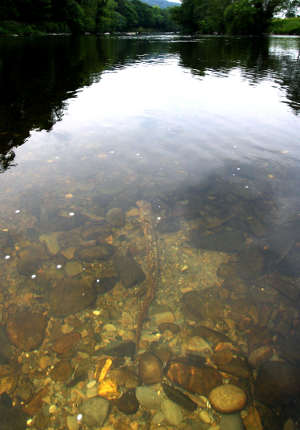Sea Lamprey (Petromyzon marinus)

The sea lamprey is a jawless, primitive fish resembling an eel. It has a mouth containing circular rows of teeth that it uses to attach itself to and feed off larger fish when at sea. The largest of the lampreys found in the UK, it occurs in estuaries and easily accessible rivers and, like the salmon, is an anadromous species (i.e. spawning in freshwater but completing its life cycle in the sea). Like the other species of lamprey (brook and river), sea lampreys need clean gravel for spawning and marginal silt or sand for the burrowing juvenile form, which are called ammocoetes. Features such as weirs and dams, as well as polluted sections of river, impede migration to spawning grounds. The species occurs in estuaries and easily accessible rivers over much of the Atlantic coastal area of western and northern Europe (from northern Norway to the western Mediterranean) and eastern North America. It has declined in some parts of its European range. In UK rivers it is reasonably widespread. In some places it is still common, but it has declined in parts of its UK range and has become extinct in a number of rivers. It appears to reach its northern limit of distribution in Scotland and does not occur north of the Great Glen. Sea lamprey is the only species currently deemed to be in favourable conservation status within the Wye Special Area of Conservation, which has one of the healthiest populations of this species in the UK and provides exceptional quality habitat in the main stem. The best time to see them is May, June and July when they start creating holes in the riverbed gravels in which they lay their eggs.
